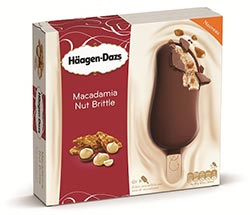The heat is on this summer in the frozen food aisles of retail stores across North America, as General Mills has debuted four varieties of Fire Roasted by Green Giant vegetables in 340-gram bags: Zucchini, Carrots & Onions; Corn, Peppers & Onion; Root Vegetables with Red Onions; and Fire Roasted Tri-Color Peppers.
 Meanwhile, Reuters has reported that General Mills would like to sell its Green Giant frozen and canned vegetable operations, and is working with investment bank Rothschild on a potential sale. The brand encompasses over 160 different products that reportedly generate approximately $700 million in annual sales.
Meanwhile, Reuters has reported that General Mills would like to sell its Green Giant frozen and canned vegetable operations, and is working with investment bank Rothschild on a potential sale. The brand encompasses over 160 different products that reportedly generate approximately $700 million in annual sales.
Across the Atlantic, on the ice cream front in the midst of a sizzling summer in France, the Minneapolis, Minnesota, USA-headquartered company’s Häagen-Dazs unit is reapting the harvest from the introduction of a new line of stick bars in five flavors: Macadamia Nut Brittle, Salted Caramel, Pralines & Cream, Vanilla Caramel Almond, and Chocolate Choc Almond.
“We have reworked all features of the stick bar so it is extremely appealing and brings real innovation to the category,” said Elodie Rebeix, project leader for Häagen-Dazs. “It has a creamier, softer texture and improved chocolate quality.”
 Previously, pointed out Rebeix, the new product development team was limited in terms of the size and the amount of pieces it could have in the ice cream. The new bar now delivers an experience that is similar to the Häagen-Dazs pint and mini-cup products that emphasize taste and texture.
Previously, pointed out Rebeix, the new product development team was limited in terms of the size and the amount of pieces it could have in the ice cream. The new bar now delivers an experience that is similar to the Häagen-Dazs pint and mini-cup products that emphasize taste and texture.
The ice cream stick bar is made at the Häagen-Dazs global plant in France. Most of the ingredients, including milk from France. The chocolate is sourced from Belgium and the vanilla comes from Madagascar
Mochi Mania Deplete Stocks Elsewhere, consumers in Japan who thought they could indulge in limited edition Häagen-Dazs Hana Mochi ice cream thorough mid-summer found themselves out of luck in this regard already in April. According to General Mills’ global communications blogger Monte Olmsted, supermarkets and convenience stores sold out of the entire 5,000,000-plus run of mini-cups within the first week of introduction.
Elsewhere, consumers in Japan who thought they could indulge in limited edition Häagen-Dazs Hana Mochi ice cream thorough mid-summer found themselves out of luck in this regard already in April. According to General Mills’ global communications blogger Monte Olmsted, supermarkets and convenience stores sold out of the entire 5,000,000-plus run of mini-cups within the first week of introduction.
“We expected consumers would find the combination of ice cream and mochi (a popular Japanese dessert made from steamed and pounded rice) a novelty,” said Ryo Morinaka, marketing manager for Tokyo-headquartered Häagen-Dazs Japan. “However, to be honest, we did not imagine it would be such a huge hit.”
In development for two years, the introduction of Hana Mochi (which translates to “splendid rice cake” and was offered in two flavors) marked the first time the company created an ice cream containing mochi. The first flavor featured kinako – roasted soybean flour – mixed with brown sugar syrup known as kuromitsu. The second boasted walnuts with a sweet soy sauce syrup known as mitarishi.
“We thought it would be a whole new way to enjoy Häagen-Dazs ice cream,” Ryo said.
Mochi can be difficult to combine with other foods, and doing so with ice cream proved challenging. But Häagen-Dazs came up with the right amount of sugar and moisture to allow the mochi to remain soft when paired with the ice cream.





